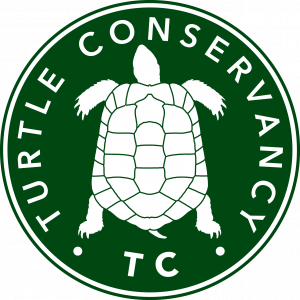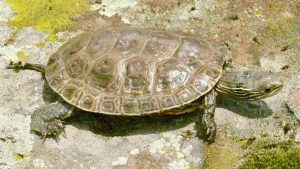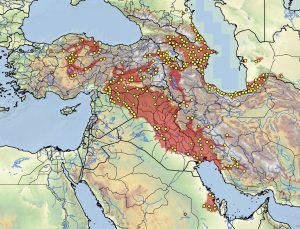Mauremys caspica, 125
Mauremys caspica (Gmelin 1774) –
Caspian Turtle, Caspian Terrapin, West Asian Stripe-necked Terrapin
Melita Vamberger1*, Stephen D. Busack2*, Dinçer Ayaz3,
Uwe Fritz1, and Liudmila F. Mazanaeva4
1Senckenberg Naturhistorische Sammlungen Dresden, Museum für Tierkunde,
Königsbrücker Landstr. 159, 01109 Dresden, Germany
[[email protected]; [email protected]];
2Emeritus Director, Research and Collections, North Carolina Museum of Natural Sciences,
Raleigh, North Carolina, USA [[email protected]];
3Department of Biology, Faculty of Science, Ege University,
35100 İzmir, Türkiye (Turkey) [[email protected]];
4Dagestan State University, Department of Zoology and Physiology,
Makhachkala, Russia [[email protected]]
*Contributed equally to the manuscript
Summary. – The Caspian Turtle, Mauremys caspica (family Geoemydidae), is a small freshwater turtle species widespread and plentiful throughout the Middle East. Although fully aquatic, it is often found in extremely arid habitats, where high concentrations may exist in small streams. It is rarely used for food, but due to landscape alteration, pollution and intensification of water management, M. caspica is increasingly threatened. The maximum straight-line carapace length (SCL) has been recorded as 25.0 cm for both sexes; however, females are usually larger on average, but males in some populations attain the same size as females.
Distribution. – Armenia, Azerbaijan, Bahrain, Georgia, Iran, Iraq, Russia (Dagestan), Saudi Arabia, Syria, Turkey, Turkmenistan.
Synonymy. – Testudo caspica Gmelin 1774, Emys caspica, Clemmys caspica, Clemmys (Clemmys) caspica, Terrapene caspica, Clemmys caspica caspica, Mauremys caspica, Mauremys caspica caspica, Testudo ecaudata Daudin 1801 (nomen novum and senior homonym), Emys caspia Rüppell in Gray 1830 (nomen novum), Testudo caspia, Clemmys caspia, Clemmys caspia caspia, Emys grayi Günther 1869 (junior homonym), Emmenia grayi, Mauremys caspica siebenrocki Wischuf in Maran 1996 (nomen nudum), Mauremys caspica schiras Wischuf in Maran 1996 (nomen nudum), Mauremys caspica ventrimaculata Wischuf and Fritz 1996, Mauremys caspica siebenrocki Wischuf and Fritz in Fritz and Wischuf 1997.
Subspecies. – None currently recognized. Two clusters of mitochondrial haplotypes (eastern and western portions of the range) and four microsatellite clusters have been delineated, defining four Management Units for conservation.
Status. – IUCN 2024 Red List: Global: Least Concern [Not Listed] (LC, assessed 1996); Regional: Europe: Vulnerable (VU A2ac+3c, assessed 2004); TFTSG Provisional Red List: Least Concern (LC, assessed 2011); CITES: Not Listed.
Citation:
Vamberger, M., Busack, S.D., Ayaz, D., Fritz, U., and Mazanaeva, L.F. 2024. Mauremys caspica (Gmelin 1774) – Caspian Turtle, Caspian Terrapin, West Asian Stripe-necked Terrapin. In: Rhodin, A.G.J., Iverson, J.B., van Dijk, P.P., Stanford, C.B., Goode, E.V., Buhlmann, K.A., and Mittermeier, R.A. (Eds.). Conservation Biology of Freshwater Turtles and Tortoises: A Compilation Project of the IUCN/SSC Tortoise and Freshwater Turtle Specialist Group. Chelonian Research Monographs 5(18):125.1–15. doi: 10.3854/crm.5.125.caspica.v1.2024; www.iucn-tftsg.org/cbftt/.
Adobe Acrobat 6.0 or later required)
Subadult Caspian Turtle, Mauremys caspica, from the foothills of Karabudakhkentsky district,
vicinity of the village of Gurbuki, Dagestan, Russia.
Photo by Liudmila F. Mazanaeva.
Distribution:
Distribution of Mauremys caspica in Turkey and the Middle East. Yellow dots = museum and literature occurrence records of native populations based on Iverson (1992), other more recent literature records (see TTWG 2017, 2021, in press), and authors’ additional data); orange dots = possibly introduced or translocated specimens. Distribution based on fine-scaled GIS-defined level 12 HUCs (hydrologic unit compartments) constructed around verified localities and then adding HUCs that connect known point localities in the same watershed or physiographic region, and similar habitats and elevations as verified HUCs based on Buhlmann et al. (2009), TTWG (2017, 2021), and data from authors and other sources.










